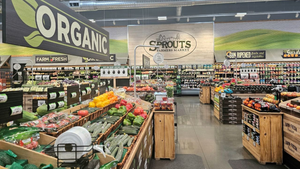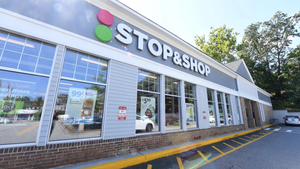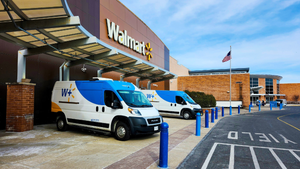WAIT AND SEEWAIT AND SEE
Collaborative planning, forecasting and replenishment has been embraced by some retailers and their trading partners. Others, however, aren't convinced the process is scalable -- able to handle multiple product categories and items -- for more accurate forecasting at the warehouse and store level.New pilot results from 12 retailers and manufacturers, however, due out this summer, should provide additional
June 14, 1999
PATRICK SCIACCA
Collaborative planning, forecasting and replenishment has been embraced by some retailers and their trading partners. Others, however, aren't convinced the process is scalable -- able to handle multiple product categories and items -- for more accurate forecasting at the warehouse and store level.
New pilot results from 12 retailers and manufacturers, however, due out this summer, should provide additional information about the viability and benefits of CPFR.
The hesitation by some retailers to jump into CPFR is in part a cultural issue, according to Jean Schenck, project manager for Uniform Code Council and CPFR supporter since its inception.
Another reason some err on the side of caution is the complexity of the technology and processes needed to make CPFR into a standard and widely used money-saving medium.
"CPFR requires diligent understanding of replenishment processes and technologies in place to manage the vast amount of data, said Scott Williams, senior project manager and representative for Procter & Gamble, Cincinnati, on the UCCnet industry project.
"These [technologies] are being developed by the leading companies as the needs and requirements are identified," he added.
One of the attractive aspects of CPFR is that only one trading partner needs to have a server and database that can be deployed over the Internet. Once one of the trading partners has made the investment in the technology, additional trading partners can be linked without significant cost, Schenck said.
"The whole thing with CPFR is that there have been decent processes for collaboration in the past, but they were manual," Schenck said.
But some companies such as Schnuck Markets, St. Louis, which support the CPFR initiative, have had to halt CPFR pilots due to other technology projects.
"We had to suspend our CPFR pilot due to Y2K priorities," said Bob Drury, vice president of management information systems for the retailer.
Twelve supermarkets and manufacturers will discuss the results of their pilot projects in a report to be published this summer by the Voluntary Interindustry Commerce Standards Association, Washington.
It is hoped the results will prove to those hesitant to try CPFR that it can perform on a wide scale.
"We've seen the overall CPFR initiative in three phases," Schenck told SN.
"The first [phase] was best practices and guidelines and the second phase was let's provide proof," she said, noting that is where the pilots enter the CPFR picture.
"Instead of putting a lot of time into pilots, the pilots were manual and small-scale," she continued, adding that even though the pilots were small, they had to show a good return to garner support for expansion.
In the highly touted Wegmans and Nabisco pilot, there were significant sales increases in the piloted Planters nut category, reduced inventory levels and improved service, all achieved through collaboration.
Schenck said third phase will be moving CPFR "up to scale" and integrating it with existing processes. She explained that the collaborative forecast process operates on the "premise of exception." "There are common criteria to determine whether the forecasting process is in control," she said, adding that the criteria could include store in-stock, forecast accuracy and turn rates for an item.
Once limits for a category are determined, items that sell outside the set limits would become the focus of the trading partners and the forecast could be adjusted accordingly.
One manufacturer on the forefront of the CPFR concept is Procter & Gamble.
"P&G's view of the CPFR process is from our raw material supplier to the retail shelf," said Williams, adding that he believed CPFR was scalable.
"As a process, CPFR makes tremendous sense and the business value will be quickly understood and then its use will become the standard," Williams said. "CPFR will build efficient volume for the partners engaged, but critical mass is important to be able to measure any real impact on a supply chain."
"[Scalability] must be the expectation for any product expected to be in-stock for consumer purchase 100% of the time," he added.
The key to forecasting a product category's future depends upon its past performance, according to the manufacturer.
"Major promotional spikes should be forecast using historical point of sale data that can allow for predictable and gradual increases in inventory to cover the increase instead of creating bullwhip supply chain surplus and shortage," he said.
P&G averages 140 days' worth of inventory in its U.S. supply chains, including raw materials, finished products and inventory in customers' distribution centers and stores. "Our supply chain optimization efforts will seek to reduce 50 percent of the inventory throughout the supply chain. CPFR is among our supply chain efforts and will play a significant role in achieving our objective," Williams said.
In-store operations efficiency is crucial to the CPFR process and insures product availability. While some trading partners are deep into the money-saving practice, others have seen it come on and go off the radar screen.
"We've got relatively small exposure to it [CPFR]," said Cathy Hotka, vice president of information technology for the National Retail Federation, Washington. "We were well plugged into it during the pilot phase where Wal-Mart was working with Warner Lambert and some others," she added.
"At this stage, though, in terms of a real live rollout, I don't think we know of anybody who is using it in any significant way. And I'm not sure that's whether it's lack of time or commitment by retailers and manufacturers," Hotka said.
About the Author
You May Also Like
.webp?width=300&auto=webp&quality=80&disable=upscale)



